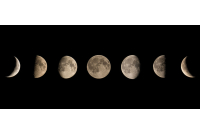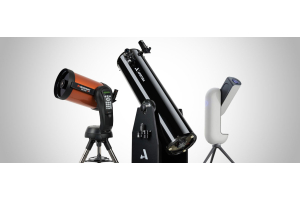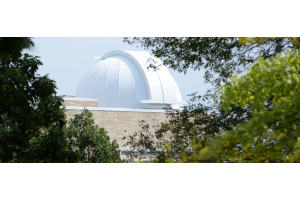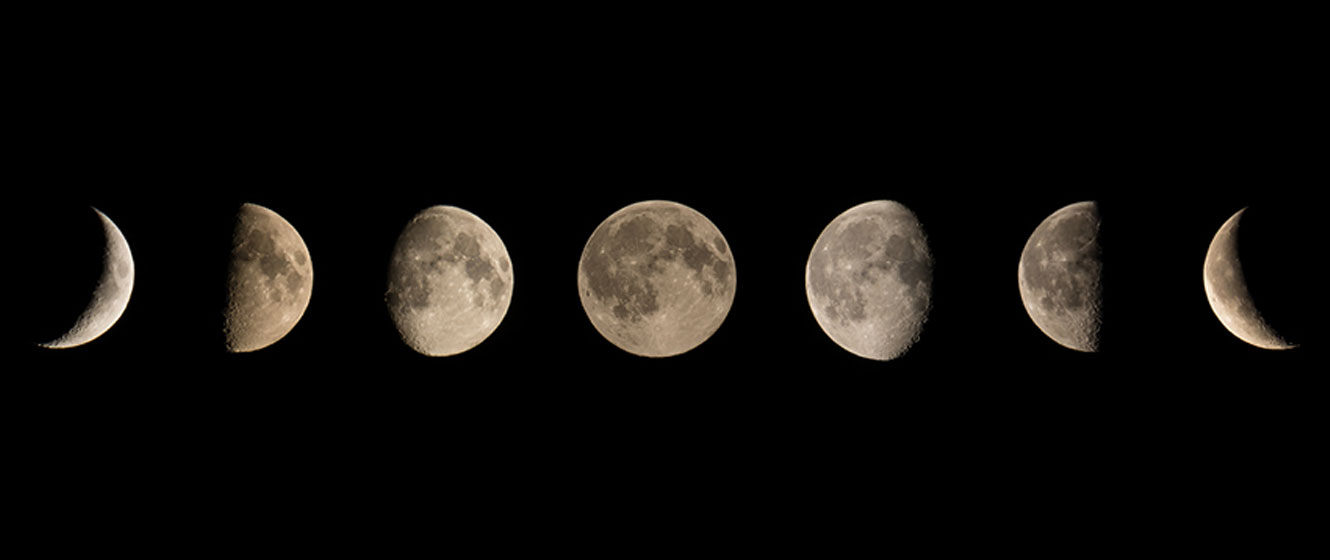
The Moon isn’t always the consistent companion we expect -- at times it’s clearly seen in the evening sky, while on other occasions it appears ghostly gray against the pale blue of the morning or afternoon. Careful observation reveals a pattern to its appearance, known as the phases - but why does this happen?
As The World Turns...
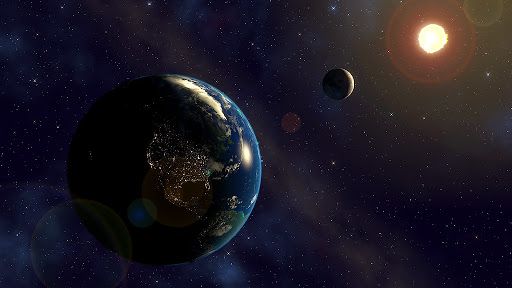
Image Credit: Kevin Gill
Let’s start with the basics. The Earth, along with the other planets in the solar system, moves along an anti-clockwise path around the Sun. The Moon, in turn, moves along an anti-clockwise path around the Earth.
The Sun, of course, radiates light and is the source of our daylight, but the Moon has no light of its own. It’s only visible because it reflects the light of the Sun. So let’s imagine ourselves very high above the north pole of the Earth. Far below us is our planet, with half of it illuminated by the light from the distant Sun, and the other half in darkness.
Just as the Earth moves around the Sun along an anti-clockwise path, so it also turns anti-clockwise on its axis. One journey around the Sun is one year on Earth, whereas a single turn on the Earth’s axis is one day.
Imagine a red dot in the middle of the illuminated half of the Earth. This dot is directly facing the Sun and, if you were standing at that location on the Earth, it would be midday and the Sun would appear toward the south.
Now imagine the Earth turning anti-clockwise, and as it moves, the red dot moves with it. It moves through the afternoon until it reaches the division between night and day.
This division, known as the terminator, is sunset on the Earth. Imagine the world turning again. The red dot moves too, through the evening until it’s in the middle of the darkened half of the Earth’s surface. This is, literally, midnight. There’s no sunlight striking this part of the Earth, so it’s smothered by the darkness of night.
Now we’re turning again, with the red dot moving through the hours after midnight until it’s on the division between night and day again. This time, it’s sunrise. The Earth continues turning and the red dot continues moving through the morning daylight hours. Lastly, we come full circle and return to the point where we started, midway along the illuminated, daylight half of the Earth. It’s midday again.
If you can imagine this, you’re halfway toward understanding the phases of the Moon and how they work. If you’re having a little difficulty, you can try a more practical experiment. Wait until it’s dark outside and then, at one end of your living room, put a flashlight on a chair.
Put a basketball, or another similarly sized ball, on a second chair, some distance away from our flashlight Sun. Make sure the flashlight is directly pointed toward the ball and then, once the lights are out and the flashlight is on, you should see half the basketball Earth illuminated by our flashlight Sun.
Place a marker in the middle of the lit side and then turn the ball slowly, in an anti-clockwise direction, to see sunset, midnight, sunrise, and midday again.
Now imagine a smaller sphere - say, a tennis ball - between the sunlit portion of the Earth and the Sun. This is the Moon. Can you see the Moon from the midnight position on the Earth? The answer is no because the Moon is on the other side of the Earth and isn’t visible from that location.
Is the Moon visible from the midday position? Again, the answer is no, because from that location, you’re looking at the unilluminated half of the Moon’s surface. There’s no sunlight hitting it, so it appears dark and invisible in our sky. This is the new Moon phase.
Incidentally, the reasons why we only see one side of the Moon and why eclipses don’t happen every month are stories for another time!
Wax On, Wax Off
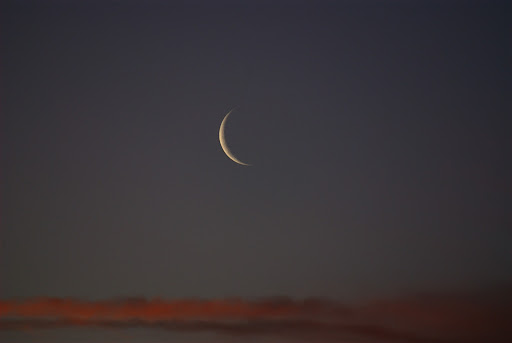
As we established earlier, the Moon moves around the Earth in an anticlockwise motion. To cut a long story short, it takes roughly (and conveniently!) four weeks to complete one orbit and to move through its cycle of phases.
As the Moon moves along its path, it slowly moves away from the Sun in our sky. By about three and a half days after the new Moon, we can see enough sunlight hitting its surface to allow the Moon to be visible as a slender crescent in our sky. This phase is known as a waxing crescent because the Moon is becoming more illuminated as the days go by.
Looking down from above, we’d see the Moon about midway along its path between the midday point on Earth (halfway along the sunlit half) and the sunset point (the terminator between night and day).
Let’s turn the Earth so that our red dot/marker is in the same position. On the surface of the Earth, we’re halfway between midday and sunset, so it’s now mid-afternoon. At this time, if you were to look carefully toward the south, you may actually see a faint, slender crescent Moon in the sky!
Because the Moon is still relatively close to the Sun in the sky, it will set soon after the Sun and will never appear as a crescent at midnight. However, it makes for a very pretty sight when it’s briefly visible in the evening twilight after the Sun goes down.
(The crescent will always point toward the Sun, so northern hemisphere observers will always see the crescent on the right side of the Moon at sunset.)
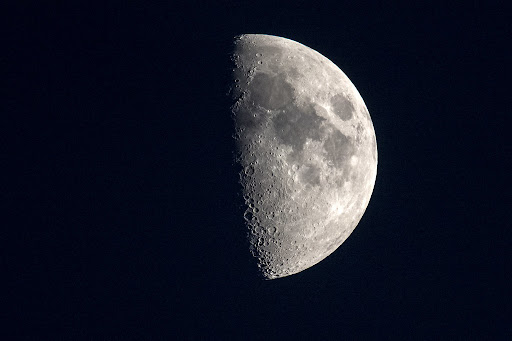
Image Credit: Tom Gill
Another three and a half days later and the Moon has completed one quarter of its orbit about the Earth. It now appears directly above the terminator on the Earth. Let’s move the red dot/marker on the Earth again, so that it’s also on the division between night and day. That’s sunset for anyone on the Earth’s surface and, again, the Moon will be seen toward the south. How does the Moon appear?
Anyone seeing the Moon at this time will see it as half illuminated. Obviously then, many people simply know it as a half moon, but the proper name for this phase is first quarter. That’s because the Moon has moved through the first quarter of its orbit.
Again, the Moon takes about 28 days to complete an orbit, and one quarter of 28 is seven. So we can reliably predict that the Moon will reach the first quarter about seven days after the new Moon - and it will appear toward the south at sunset. You will never see a first quarter Moon toward the south at any other time of night.
(Following this logic, the first quarter Moon will typically rise around midday and set around midnight.)
Three and a half days later and the Moon is now midway between being half and fully illuminated. This gives it an unusual shape - not to mention an unusual name. This phase is called a waxing gibbous. The Moon is still waxing because it’s becoming more illuminated, and gibbous means “bulging” or, more appropriately, “convex”.
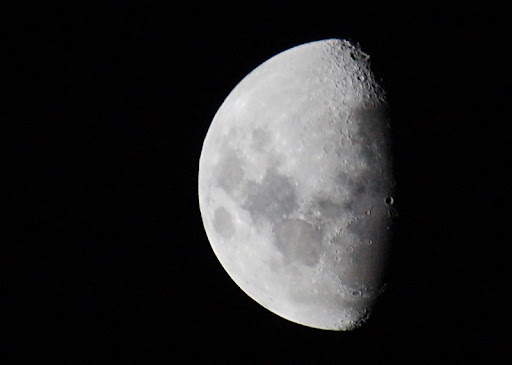
On Earth, the waxing gibbous Moon appears toward the south around mid-evening - halfway between sunset and midnight.
Adding another three and a half days brings us to fourteen days, or two weeks, since the new Moon. By this time, the Moon has completed half its orbit around the Earth and is now on the opposite side of the planet from the Sun. This is the full Moon, as it’s now fully illuminated by sunlight. (The Earth won’t typically block the Sun from the Moon because the orbits of the Earth and Moon aren’t perfectly aligned.)
Similarly, the Moon is opposite the Sun in the sky, so the full Moon will rise at sunset, be visible throughout the entire night, and then set at sunrise. It appears toward the south around midnight.
The Waning of the Light
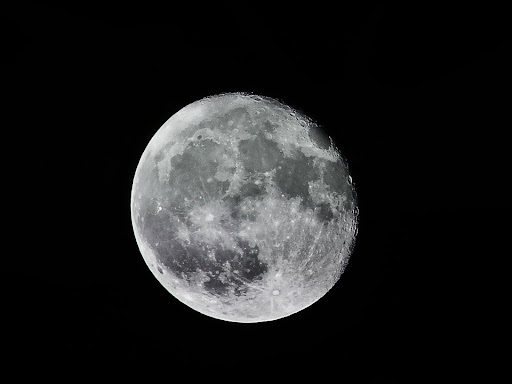
Image Credit: NASA
All of the phases so far have predominantly been visible throughout the evening hours, but as we move past the full Moon, it will continue to rise later and become visible during the morning hours.
The Moon will also start to become less illuminated. For the first two weeks of the lunar phases, the Moon was said to be waxing, because it was growing fuller from our point of view. Now the Moon will appear to be growing darker, so we say the Moon is now waning.
Three and a half days past full Moon and it’s now slimmed down to a waning gibbous. Just as with the waxing gibbous, most of its surface is illuminated, but it appears as an odd convex shape again.
It will typically rise late in the evening, appear over the southern horizon about halfway between midnight and sunrise, and then set about halfway between sunrise and midday.
As soon as the Moon begins to wane, you’ll start to see much less of it in the evening sky and much more of it in the morning sky. As the days go by, it will set later and appear higher in the hours before midday.
Three and a half days later, the Moon has moved along its path so that it’s now over the terminator again - but this time, it’s the division between the night and the day that marks the dawn. It’s now been one week since the full Moon, two weeks since the first quarter Moon and three weeks since the new Moon.
The Moon is three quarters of the way along its path and only has one more quarter to go. As a result, this phase is called the last quarter Moon. It’s similar to the first quarter as it appears as a half Moon, but it’s the opposite half of the Moon that’s illuminated.
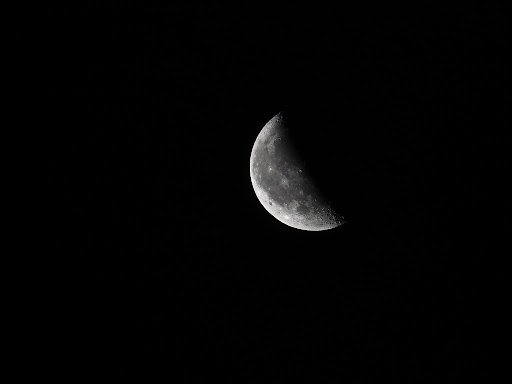
Just as the first quarter Moon appeared toward the south at sunset, the opposite is also true of the last quarter Moon. If we were to move our red dot/marker on the basketball Earth so that it’s facing the tennis ball Moon, we’d be seeing the Moon toward the south at sunrise.
We have one more week until we return to the new Moon and our starting point. Three and a half days later, the Moon has slimmed down to a crescent. Again, just as the waxing crescent Moon was visible in the evening sky just after sunset, so the waning crescent Moon is visible in the morning sky just before sunrise.
The Moon is now midway between the dawn terminator and the midday point on the Earth’s surface, so it will appear to the south around mid-morning. Like the waxing crescent Moon, the sunlit portion will always point toward the Sun but it might be tricky to see in the bright daylight.
Three and a half days later and the full four weeks have elapsed. The Moon is now new again and the cycle starts over. In one week you’ll see a half Moon over the southern horizon at sunset. In two weeks' time, a full Moon will be visible throughout the entire night. In three weeks, you’ll see the half Moon in the morning sky, and in another four weeks we can start counting again.
| Phase | Days Past New (Age) | Rises | Appears Toward the South | Sets |
|---|---|---|---|---|
| New | 0 | Sunrise | Midday | Sunset |
| Waxing Crescent | 3.5 | Mid Morning | Mid Afternoon | Mid Evening |
| First Quarter | 7 | Midday | Sunset | Midnight |
| Waxing Gibbous | 10.5 | Mid Afternoon | Mid Evening | Mid Pre-Dawn Hours |
| Full Moon | 14 | Sunset | Midnight | Sunrise |
| Waning Gibbous | 17.5 | Mid Evening | Mid Pre-Dawn Hours | Mid Morning |
| Last Quarter | 21 | Midnight | Sunrise | Midday |
| Waning Crescent | 24.5 | Mid Pre-Dawn Hours | Mid Morning | Mid Afternoon |
The inconsistent Moon can be confusing if you expect to see it in the evening sky every night. For at least two weeks out of every four, it simply won’t be there and you’ll need to catch it in the morning instead.
Astronomers, however, have learned to literally count the days; they know that between the first and last quarter phases, the Moon can brighten the sky and drown out the light from fainter deep sky objects. They know to wait until the last quarter Moon, when it won’t rise until midnight, if they want to observe in the evening.
The Moon may be inconsistent to some, but astronomers, at least, have come to count on its clockwork motions.
This Article was Last Updated on 08/14/2023






